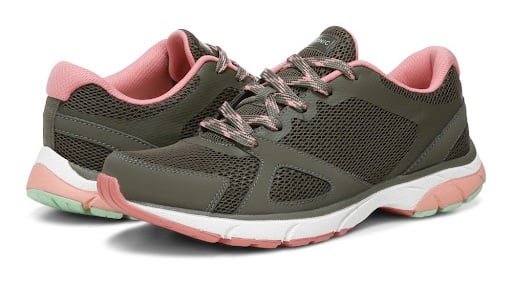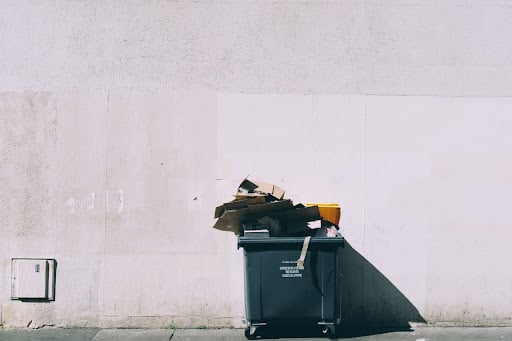
Your favorite pair of sneakers have grown tired. They fit you like a glove and have accompanied you on nearly every adventure (even the ones they weren’t welcomed on), so it can feel like a shame to toss your old kicks aside after all those years.
Thankfully, there are many ways to give your old pair of runners a new life.
You don’t have to doom your faithful pair of athletic sneakers to a life in the landfill. Instead, there are some better ways to extend the duration of your running shoes and reduce your carbon footprint. Wondering how to recycle shoes? This shoe recycling guide will tell you everything you need to know about ways to recycle sneakers, ensuring your runners can continue to live on for years to come.
Ways to Properly Recycle Your Sneakers
There’s no one way to properly recycle old sneakers (or even walking shoes for women). You might think your running shoes are ratty beyond use, but we can guarantee there’s still a life for your athletic sneakers out there somewhere. Just imagine what you could do if you steered your unwanted athletic shoe pairs towards a purpose like a shoe drive .
Need help brainstorming some ways to properly recycle your old shoes? Here are four options to choose from:
- Recycle sneakers to turn their materials into new products.
- Donate your good condition shoes to a local organization for others to wear and enjoy.
- Repair shoes and give them a new life by taking them to a cobbler.
- Upcycle your good condition shoes and modify them into a new sustainable fashion.
How to Recycle Your Shoes Into New Materials
Unfortunately, your local recycling bins aren’t equipped to recycle shoes. Most city-wide recycling programs are designated for materials that include cardboard, paper, metal, glass, and certain plastics. But that doesn’t mean you don’t have options.
If you want to donate your shoes to be recycled into a new form, try looking into a textile recycling company or textile bin dropoff in your area. These are a great way to reduce your carbon footprint while giving your exercise shoes new life. Oftentimes, you’ll see these bins near shopping centers, but you can ask around in your community to gain some local insight.1
Textile recycling companies can turn your old pair of sneakers into several different materials that hardly resemble shoes at all. When these companies work their recycling magic, these are just a few things that can be made from your shoes:2
- Insulation
- Surfacing for playgrounds and courts
- Carpet padding
- Textiles
The Benefits of Recycling Your Shoes
Every year, 24.2 billion pairs of shoes are made globally. And because of the large number of products being produced, a majority of that material finds its way to the landfill. Although your shoes contain natural materials, they also contain plastic which could take hundreds of years to break down.
Your urge to not throw out your pair of shoes is likely saving them from decades spent sitting in a landfill. This, in turn, saves the surrounding groundwater from plasticizers and toxic chemicals that your shoes can leak.3
When done properly, recycling your shoes can help:2
- Save closet space – Instead of letting your old shoes gather dust in your closet. You can recycle them so that they get more use. They take up less space and can be utilized for a better purpose.
- Protect the environment – By giving your shoes to a recycling program, you prevent them from inevitably ending up in the landfill, where they can decompose and leak chemicals. In turn, they can be reused to promote eco friendly fitness.
- Provide new materials – Sneakers contain a variety of useful materials like rubber, fabric, foam, and leather. When you provide these materials, you’re saving the carbon emission that would’ve been required to make them from scratch.
How to Donate Your Shoes
We understand that fashion trends can often fade before your pair of shoes has even kicked the bucket. Donating can be an effective and simple way to reduce your carbon footprint, while also providing a pair of shoes that someone else might need.
Here’s a breakdown of what shoes are in most demand:3
- Walking shoes for men and women
- Soccer shoes
- Men’s dress shoes
For other shoe types—like high heels, which are reportedly the least in demand—you can find other ways to donate them locally or even offer them up for free on an online marketplace. For more tips on how to manage your less desirable shoes, keep reading below.
The Correct Way to Donate Your Shoes
Believe it or not, there is a right and a wrong way to go about donating your old footwear. With such an abundance of well-loved boots, sneakers, and flats being dropped off at local shops, it can be challenging to stay on top of such a high inventory. Even local donation stores only sell around 25% of shoes to customers in your area. The rest are exported to emerging countries.
While there is some demand in these areas, a majority of the shoes exported end up flooding local markets abroad. These flooded markets put pressure on local salespeople, disrupting economies in the community and creating more supply than demand.
The shoes you donate can just end up in the landfill anyway if you’re not careful. That’s why we recommend:
- Donating less popular shoes to companies that work with local communities to put money back in the pockets of local citizens.
- One example of this is Soles-4-Souls. They accept shoe donations and then help disadvantaged individuals start and sustain their own small business of selling shoes.
So, before filling bags and boxes with shoes for donation, consider what organizations might be best equipped to handle higher quantities.
Repairing Your Shoes
When you hear the word “cobbler”, you might imagine a craftsman from hundreds of years ago. Contrary to popular belief, however, the field of cobblers is alive and well. If you’re still a fan of your favorite old pair, you can make them as good as new again through the work of a local shoe repairman.
Cobblers are able to fix just about any type of shoe ailment—they can provide new soles on your sneakers, add new heels, or even change the color of your shoes. Even if you think your pair is beyond repair, odds are, a cobbler has found a solution around it.
The only problem is that repairs can sometimes get pricey, depending on how worn your shoe is. Because of this, it’s recommended that you take your shoes in for upkeep before they get too worn down.

Repair Your Shoes At Home
If there isn’t a cobbler near you, or your budget doesn’t support a more substantial repair, you can always try to repair your shoes at home (try an at home workout while you’re at it to increase your eco friendly ways). Here are some tactics you can use for some DIY shoe operations:4
- Fix holes with an adhesive – Dedicated shoe glue can help you patch up damages to your footwear. Use this to fix holes, fraying fabric, or reattach soles and heels. You can also use certain adhesives to protect shoes from the rain, saving you both money and a soggy shoe.
- Revive shoe leather with polishes and dyes – Leather shoe polish can help minimize scuffs and marks, making your leather shoes look brand new. Likewise, a dye can help restore the color of your footwear to make them look like they’re fresh out of the box.
- Clean stains with a fabric cleaner – Sometimes, the aged look of our shoes is accumulated from dirt and grass stains that buildup over time. There are several shoe fabric cleaners with brushes you can use to scrub away stains and brighten up your sneaker fabrics.
Upcycle Your Shoes
Most recycling that people think of is considered downcycling—the process of turning high-value products into lower-value products. Upcycling turns regular recycling on its head, taking old materials and making them into higher valued materials.
There are ways that you can upcycle your shoes even at home. Try a DIY project that gives your sneakers a new look, either with new laces, patches, or a painted design on the fabric. Upcycling can allow you to enjoy a pair that’s no longer your style and turn them into a pair that’s fashionable and trendy.5
Here are some ways that you can upcycle your own pair of shoes:6
- Iron a new pattern on cloth shoes – With this, you can turn a simple pair of white sneakers into a patterned fashion statement.
- Use a paint pen to add a new design to your favorite pair – Paint can go a long way, and some simple designs can help you cover up scuffs and give your old footwear a brand new feel.
- Sew on new fabric to replace holes or ruined corners – Denim, suede, canvas, lace—in the world of fabric, your options are nearly endless. You can even try combining these new fabrics in an innovative, eye-catching way.
The Benefits of Upcycling
Feeling stuck between recycling your old sneakers or upcycling them? If you’re looking for a method to reduce more of a carbon footprint, upcycling might be your best option. When you recycle, energy is used to convert your shoes back into their smallest components.
The energy needed for this conversion requires time, labor, and emissions. And once these elements have been pared down to their simplest form, they need to be reprocessed into new materials and products. Upcycling keeps these products at their original form, allowing them to be reused at their highest value—and preserving the time and energy that recycling requires.7
Choose Shoes That Don’t Wear You Down With Vionic
After years of wearing your favorite pair of sneakers, you might be unaware that your shoes can do the same to your feet. Years of wearing unsupportive sneakers can leave their mark. Rather than succumb to sore feet, why not try a stylish pair of shoes that don’t sacrifice fashion for comfort?
Vionic can help you find your desired comfort with our Vio-Motion™ footbed technology. We provide a wide range of innovative footwear—from sandals to sneakers, boots, and insoles—granting you a new spring in your step. Even for all the years—and footsteps—to come, your shoes will continue to deliver you comfort and ease.
Sources:
- “How to Recycle Shoes or Dispose Them.” Shoerazzi. 10 July, 2021. https://shoerazzi.com/how-to-recycle-shoes/
- “Benefits of Recycling Your Sneakers.” Got Sneakers? https://gotsneakers.com/benefits-of-recycling-your-sneakers/
- Cline, Elizabeth. “Ask a sustainability expert: how do i recycle my worn-out shoes?” Fashionista. 13 February, 2020. https://fashionista.com/2020/02/how-to-recycle-shoes-sneakers-heels
- Cassano, Maria. “How To Make Old Shoes Look New Again, According To A Shoe-Repair Pro.” Bustle. Updated 1 August, 2021. https://www.bustle.com/fashion/168189-how-to-make-old-shoes-look-new-again-with-10-genius-hacks
- “What to do with your old shoes.” Shoezone. 11 March, 2021. https://www.shoezone.com/Blog/how-to-recycle-shoes
- Amy. “Upcycle Shoes with One of these Genius Ideas.” DIY Candy. Updated 9 June, 2021. https://diycandy.com/upcycle-shoes/
- Wever, Agnes et Dasnois, Mathieu.” Metabolic. 2 March, 2021. https://www.metabolic.nl/news/recycling-downcycling-and-the-need-for-a-circular-economy/?gclid=Cj0KCQiAzfuNBhCGARIsAD1nu-8aBE5M_3xifmfhXBTr2yCWZ4tgCdKCIUzgeQy5tzi_wnT0x8i4aOcaAumVEALw_wcB



Leave a Reply